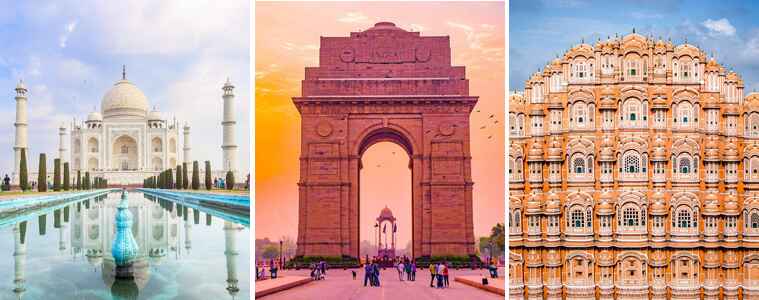Agra, a city steeped in history and grandeur, was once the heart of the Mughal Empire. The majestic Monuments Built by Mughals during this era stand as testaments to the empire’s architectural prowess and cultural richness. From the iconic Taj Mahal to the lesser-known tombs and mosques, historical monuments in Agra offers an unparalleled glimpse into the legacy of the Mughal era monuments.
Explore the Monuments Built by Mughals of Agra
Agra, a treasure trove of historical monuments, beautifully reflects the architectural brilliance of the Mughal era monuments. Among the monuments built by Mughals, the Taj Mahal stands as a world-famous symbol of love, captivating millions with its marble grandeur. The Agra Fort, another UNESCO World Heritage site, showcases a perfect blend of power and elegance through its intricate palaces and majestic gates. Exploring historical places in Agra isn’t complete without visiting Fatehpur Sikri, a striking city of red sandstone and timeless artistry. The delicate Itmad-ud-Daulah and Akbar’s Tomb in Sikandra highlight the Mughals’ artistic vision. Agra’s rich tapestry of architecture invites you to experience the grandeur of a bygone era through its spectacular historical monuments in Agra. In this article, we will explore the top 9 must see Mughal era monuments in Agra that you should not miss.
List of Top 9 Must See Monuments Built by Mughals In Agra
1. Taj Mahal: The Symbol of Love
No visit to Agra is complete without witnessing the breathtaking beauty of the Taj Mahal. This white marble mausoleum was built by Emperor Shah Jahan in memory of his beloved wife Mumtaz Mahal. The Taj Mahal’s stunning architecture, intricate carvings, and magnificent gardens make it a UNESCO World Heritage site and one of the Seven Wonders of the World. For those looking to experience the Taj Mahal at its most enchanting, consider opting for a Taj Mahal Sunrise Tour, where you can see the monument bathed in the soft golden light of the early morning. Alternatively, a Same Day Taj Mahal Tour will allow you to explore this timeless beauty along with other historic sites in Agra in a single day.
Visting Time: Open daily 30 minutes before Sunrise to 30 minutes before Sunset, Friday Closed.
Entry Fee:
- Indian Tourist: 50 + 200 Main Mausoleum (Optional)
- Foreign Tourist: 1100 + 200 Main Mausoleum (Optional)
- SAARC and BIMSTEC Tourist: 540 + 200 Main Mausoleum (Optional)

2. Agra Fort: The Red Fort of Agra
The Agra Fort, also known as the Red Fort Agra, is another historical places in Agra from the Mughal era monuments that showcases the opulence of Mughal architecture. Built by Emperor Akbar in the 16th century, this fort served as the main residence of the Mughal emperors until 1638. The fort’s massive red sandstone walls, intricate interiors, and panoramic views of the Taj Mahal make it a must-visit.
Understanding the Agra Fort History is key to appreciating the fort’s significance. The fort is not just a military structure, but also a symbol of the wealth and power of the Mughal Empire. You can learn more about its importance in India’s history during the visit of your historical monuments in Agra.
Visting Time: Open days of week 6 AM To 6 PM.
Entry Fee:
- Indian Tourist: 50
- Foreign Tourist: 650
- SAARC and BIMSTEC Tourist: 90

3. Fatehpur Sikri: The Abandoned Mughal City
Fatehpur Sikri, located just outside Agra, was built by Emperor Akbar in the 16th century as his capital city. The city is an incredible mix of Islamic, Persian, and Indian architectural styles. The most notable structures within Fatehpur Sikri include the Buland Darwaza, the largest gateway in the world. A visit to Fatehpur Sikri Agra offers insight into Akbar’s vision for his empire and his attempt to create a perfect city and one of the best monuments built by Mughals. Though abandoned later, this historic city is one of the finest examples of Mughal era monuments.
Visiting Time: Open daily from Sunrise to Sunset.
Entry Fee:
- Indian Tourist: 50
- Foreign Tourist: 610
- SAARC and BIMSTEC Tourist: 50
4. Akbar Tomb (Sikandra): A Mausoleum of Grandeur
The Akbar Tomb Sikandra is a striking example of Mughal architecture located just outside the main city of Agra. This tomb was built by Akbar’s son, Emperor Jahangir, in the early 17th century. It is an excellent blend of Islamic, Persian, and Hindu architectural elements and one of the historical monuments in Agra. The Agra Akbar Tomb is known for its grand gateway, gardens, and a central mausoleum that stands majestically at the heart of the complex. The monument is a peaceful retreat and provides a glimpse into Akbar’s life and legacy. It is also where Akbar the Great was laid to rest.
Visiting Time: Open daily from Sunrise to Sunset.
Entry Fee:
- Indian Tourist: 30
- Foreign Tourist: 310
- SAARC and BIMSTEC Tourist: 30

5. Mariam Tomb: The Tomb of Akbar’s Queen
Located near the Akbar the Great Tomb, the Mariam Tomb is the burial site of Mariam-uz-Zamani, Akbar’s beloved wife. This tomb is a mix of Islamic and Mughal architectural styles, with intricately designed gardens and tombstones. The tomb is not as crowded as other monuments built by Mughals in Agra, making it an ideal place for those seeking a quieter, more contemplative experience. The architecture of the tomb, with its symmetrical layout and floral motifs, reflects the sophistication of the Mughal period.
Visiting Time: Open daily from Sunrise to Sunset.
Entry Fee:
- Indian Tourist: 25
- Foreign Tourist: 300
- SAARC and BIMSTEC Tourist: 25
6. Mehtaab Bagh: The Moonlit Garden
For those who want to experience the Taj Mahal from a unique perspective, Mehtaab Bagh offers a perfect opportunity. Situated on the opposite bank of the Yamuna River, this garden offers one of the best views of the Taj Mahal, especially at sunset or under the moonlight. The garden’s design is a reflection of the original Taj Mahal’s layout, and it provides a peaceful escape from the hustle and bustle of Agra. A visit to Mehtaab Bagh is especially recommended for photography enthusiasts who want to capture the Taj Mahal in its entirety from across the river.
Visiting Time: Open daily from Sunrise to Sunset.
Entry Fee:
- Indian Tourist: 25
- Foreign Tourist: 300
- SAARC and BIMSTEC Tourist: 25
7. Itimad-ud-Daulah: The Baby Taj
Often referred to as the Baby Taj, the Itimad-ud-Daulah Tomb is a beautiful marble structure built by Empress Noor Jahan in memory of her father, Mirza Ghiyas Beg. This historical monuments in Agra is considered to be a precursor to the Taj Mahal in terms of its architectural style, featuring marble inlay work and intricate carvings. Visiting the Itimad-ud-Daulah Tomb is a chance to see some of the finest examples of Mughal craftsmanship and mughal era monuments, including the delicate Pietra dura work (stone inlay) that would later be featured in the Taj Mahal. The monument is set in a serene garden, providing a tranquil atmosphere for visitors.
Visiting Time: Open daily from Sunrise to Sunset.
Entry Fee:
- Indian Tourist: 30
- Foreign Tourist: 310
- SAARC and BIMSTEC Tourist: 30

8. Chini Ka Rauza: A Monument of Persian Influence
The Chini Ka Rauza is a lesser-known gem located in Agra. Built in the early 17th century, it is the tomb of the Persian scholar and poet, Allama Afzal Khan. The structure is notable for its Persian-style architecture and the extensive use of blue and turquoise tiles, which set it apart from other Mughal tombs and one of the historical places in Agra. This monument is an excellent example of the fusion of Persian and Mughal styles, and the intricate tile work makes it a must-visit for those interested in exploring more about the Mughal Empire’s cultural exchanges.
Visiting Time: Open daily from Sunrise to Sunset.
Entry Fee: Entry is Free, No Ticket Required
9. Jama Masjid In Agra: A Majestic Mughal Mosque
The Jama Masjid in Agra, located near the Agra Fort, is one of the largest and most beautiful mosques in India. Built by Emperor Shah Jahan in 1648, the mosque’s architecture reflects the grandeur of the Mughal period. The mosque’s large red sandstone structure and white marble domes are stunning examples of Mughal craftsmanship and best mughal era monuments. For those interested in the Mughal religious architecture, the Jama Masjid Agra offers insight into the spiritual side of the empire. The mosque’s intricate calligraphy, marble inlay work, and peaceful surroundings make it a must-visit on your journey through Agra.
Visiting Time: Open daily from Sunrise to Sunset.
Entry Fee: Entry is Free
Conclusion:
The Mughal Empire left an indelible mark on India’s architectural landscape, and Agra remains one of the best places to explore this rich history. From the world-renowned Taj Mahal to the lesser-known monuments like Chini Ka Rauza, the historical places in Agra offer something for everyone.
If you’re planning a trip to Agra and want to explore these magnificent Mughal era monuments, consider booking a tour with The Imperial Tour. They offer expertly guided tours that ensure you don’t miss out on the fascinating history and architectural beauty of Agra. Whether you’re visiting the Taj Mahal on a Same Day Taj Mahal Tour or discovering the lesser-known gems of the city, The Imperial Tour will make your experience unforgettable. Explore Agra’s magnificent monuments and immerse yourself in the rich history of the Mughal Empire, a journey that promises to be both educational and awe-inspiring.
Follow US: Facebook, Instagram








